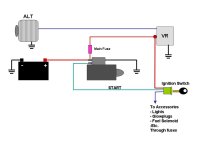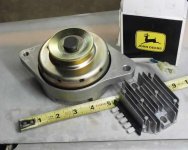ThomasH
Gold Member
I think there is a bit of confusion in some of the postings on this subject. Current is determined by the amount of resistive load in the circuit. If there are item(s) with partial short circuits, such as a battery with a shorted cell, it will increase the amperage draw on the alternator. No amount of bad connections, etc., will *increase* amperage in the circuit, they will in fact cause it to decrease. And typically overheat a well and probably fail at some point if they are bad enough.
With that said, you have already diagnosed a heavy drain on the circuit, which includes accessories (lights, etc), glow plugs, and the battery. How you diagnosed it was to note that the wire going from the alternator to the battery (or B+ junction) was getting hot and there was a significant voltage drop across the wire. A normal voltage drop on across that wire would be .1 to .2 volts. This high a drop indicates that either the wire is defective (possible, but can be easily looked at for corrosion or an obvious physical defect), or that the load on that circuit is causing the problem.
It's possible that the battery has a shorted cell, the glow plugs are staying on, or some other abnormal thing. Batteries are not hard to check, and having a shorted cell is not terribly uncommon so I would start there. You can also check the glow plug circuit to see if there is voltage at any of the glow plugs while it is running.
Good luck!
With that said, you have already diagnosed a heavy drain on the circuit, which includes accessories (lights, etc), glow plugs, and the battery. How you diagnosed it was to note that the wire going from the alternator to the battery (or B+ junction) was getting hot and there was a significant voltage drop across the wire. A normal voltage drop on across that wire would be .1 to .2 volts. This high a drop indicates that either the wire is defective (possible, but can be easily looked at for corrosion or an obvious physical defect), or that the load on that circuit is causing the problem.
It's possible that the battery has a shorted cell, the glow plugs are staying on, or some other abnormal thing. Batteries are not hard to check, and having a shorted cell is not terribly uncommon so I would start there. You can also check the glow plug circuit to see if there is voltage at any of the glow plugs while it is running.
Good luck!


